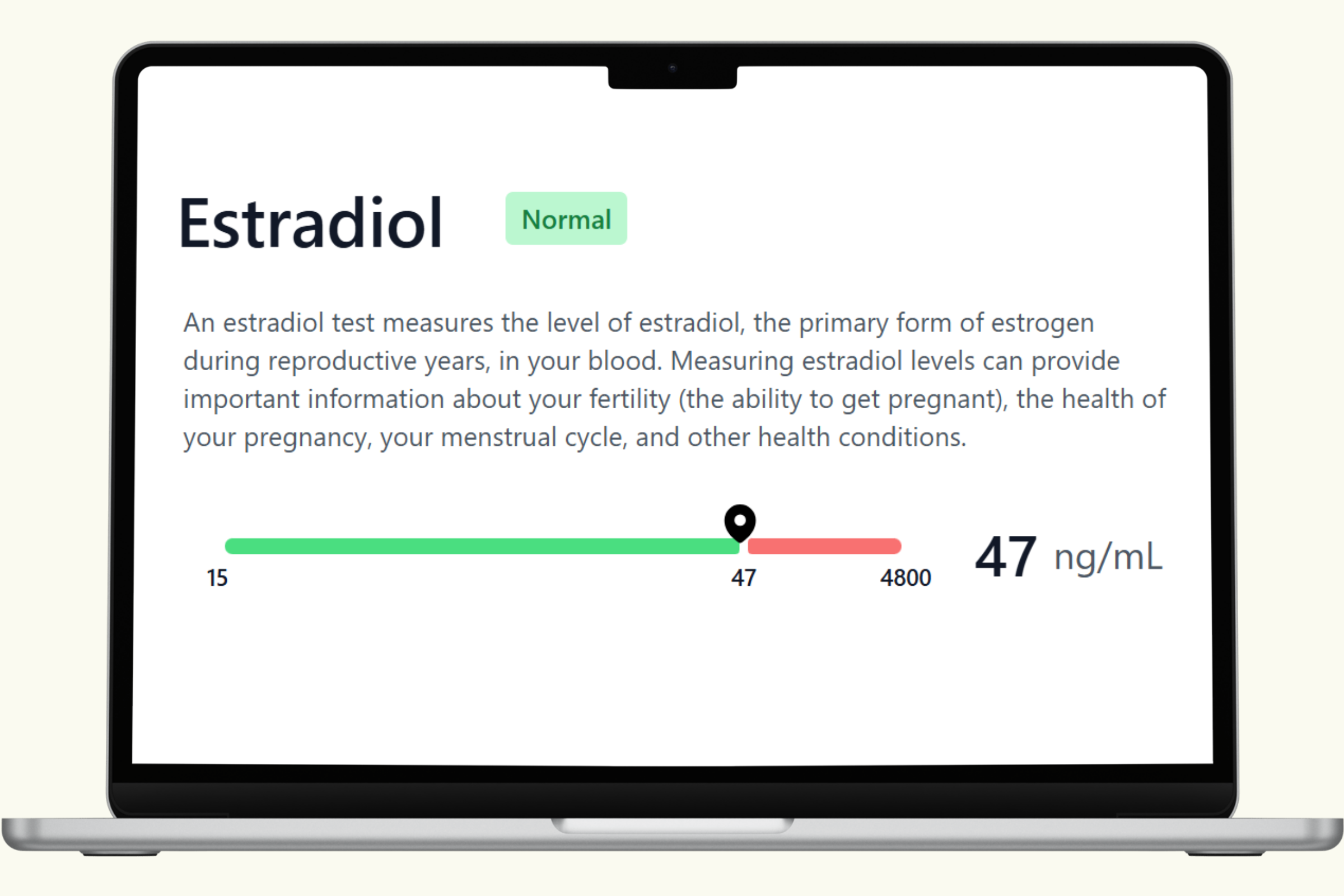Estradiol (E2) Blood Test: Understanding Estrogen Balance in Men
The Estradiol (E2) Blood Test, included in the PlexusDx Men’s Hormone Blood Test, measures estradiol, the most biologically active form of estrogen. While estrogen is often thought of as a “female hormone,” men also produce estradiol, primarily in the testicles, with smaller amounts made in the brain, fat tissue, immune cells, and bones. Maintaining balanced estradiol is essential for men’s overall health, especially when it comes to reproductive health, thyroid and brain function, bone density, and weight regulation.
What is Estradiol (E2)?
Estradiol is a type of estrogen and the most potent form found in humans. In men, it is produced both directly in the testicles and through the conversion of testosterone into estradiol by the enzyme aromatase. Although estradiol circulates at much lower levels in men compared to women, it still plays a vital role in maintaining balance across multiple systems.
Functions of Estradiol in Men
Estradiol supports numerous critical processes, including:
- Reproductive health: Regulates libido, erectile function, and sperm development.
- Thyroid and brain function: Supports cognitive health, mood regulation, and thyroid hormone activity.
- Bone density: Helps maintain strong bones and prevent osteoporosis.
- Weight balance: Influences body fat distribution and metabolism.
- Cardiovascular health: Plays a role in protecting blood vessels and regulating cholesterol.
Total vs. Free Estradiol
In the bloodstream, most estradiol is bound to proteins like sex hormone-binding globulin (SHBG) and albumin. Only about 1% circulates as free estradiol, which is biologically active and able to interact with tissues. Because measuring free estradiol is technically challenging, most clinical tests—including those used by PlexusDx—measure total estradiol, which includes both bound and unbound forms.
Why Men Should Test Estradiol
Estradiol testing is valuable in men for several reasons:
- Low estradiol levels: Can lead to bone loss, osteoporosis, joint pain, and reduced libido.
- High estradiol levels: Often associated with obesity, gynecomastia (breast tissue growth), infertility, and erectile dysfunction.
- Hormone replacement monitoring: Estradiol is often measured in men undergoing testosterone replacement therapy to prevent excessive conversion of testosterone into estrogen.
- Thyroid and metabolic health: Abnormal estradiol may reflect thyroid imbalances, liver issues, or metabolic dysfunction.
Reference and Functional Ranges
Estradiol levels in men are much lower than in women but still clinically important. Common ranges include:
- Standard reference range (adult men): 10 – 40 pg/mL
- Functional/optimal range: 20 – 30 pg/mL, depending on age and overall health
Results should always be interpreted alongside testosterone, SHBG, and luteinizing hormone (LH) for a complete picture of hormonal balance.
Factors That Influence Estradiol in Men
Several factors can raise or lower estradiol levels in men:
- Age: Estradiol levels may rise as men age due to increased aromatization of testosterone.
- Body composition: Excess body fat increases aromatase activity, raising estradiol.
- Liver health: Since estradiol is metabolized in the liver, liver conditions can alter levels.
- Medications: Testosterone therapy, anabolic steroids, or aromatase inhibitors can all influence estradiol levels.
- Thyroid status: Thyroid imbalances can shift estradiol production and binding.
Symptoms of Estradiol Imbalance in Men
- Low estradiol: Fatigue, low libido, joint pain, osteoporosis, mood changes.
- High estradiol: Gynecomastia, weight gain (especially belly fat), infertility, erectile dysfunction, mood swings.
How the Estradiol Test Works
The PlexusDx Estradiol Blood Test is performed using a simple at-home dried blood spot collection method with an ADX card. This allows for fast, convenient, and accurate results without the need for traditional blood draws. Once your sample is mailed to the lab, results are processed and delivered securely online.
Interpreting Estradiol with Other Hormone Tests
Estradiol doesn’t act in isolation. It must be evaluated alongside other hormones for accurate insights:
- Testosterone: Estradiol is largely produced by converting testosterone, making it vital to measure both.
- SHBG: Influences how much estradiol is free and biologically active.
- LH and FSH: Help identify whether imbalances originate from the testes or pituitary gland.
Key Takeaways
- Estradiol is the most active form of estrogen and plays an important role in men’s reproductive, bone, brain, and metabolic health.
- Only about 1% of estradiol is free and biologically active, so most tests measure total estradiol.
- High estradiol in men can contribute to gynecomastia, infertility, and weight gain, while low estradiol increases risk of osteoporosis and joint problems.
- PlexusDx makes estradiol testing simple with at-home dried blood spot collection.
- Interpreting estradiol alongside testosterone, SHBG, and LH provides the most accurate picture of male hormone balance.
Final Thoughts
The Estradiol (E2) Blood Test is an essential component of men’s hormone health assessment. While often overlooked, estradiol has profound effects on bone strength, reproductive health, mood, and metabolism. Abnormal levels may explain symptoms such as infertility, weight changes, or reduced vitality. With the convenience of at-home testing, PlexusDx empowers men to gain a deeper understanding of their hormonal health and take proactive steps toward balanced well-being.

Share:
Luteinizing Hormone (LH) Blood Test